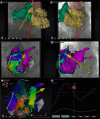Best practices in robotic magnetic navigation-guided catheter ablation of cardiac arrhythmias, a position paper of the Society for Cardiac Robotic Navigation
- PMID: 39399515
- PMCID: PMC11466809
- DOI: 10.3389/fcvm.2024.1431396
Best practices in robotic magnetic navigation-guided catheter ablation of cardiac arrhythmias, a position paper of the Society for Cardiac Robotic Navigation
Abstract
Preamble: Robotic magnetic navigation (RMN)-guided catheter ablation (CA) technology has been used for the treatment of cardiac arrhythmias for almost 20 years. Various studies reported that RMN allows for high catheter stability, improved lesion formation and a superior safety profile. So far, no guidelines or recommendations on RMN-guided CA have been published.
Purpose: The aim of this consensus paper was to summarize knowledge and provide recommendations on management of arrhythmias using RMN-guided CA as treatment of atrial fibrillation (AF) and ventricular arrhythmias (VA).
Methodology: An expert writing group, performed a detailed review of available literature, and drawing on their own experience, drafted and voted on recommendations and summarized current knowledge and practice in the field. Recommendations on RMN-guided CA are presented in a guideline format with three levels of recommendations to serve as a reference for best practices in RMN procedures. Each recommendation is accompanied by supportive text and references. The various sections cover the practical spectrum from system and patient set-up, EP laboratory staffing, combination of RMN with fluoroscopy and mapping systems, use of automation features and ablation settings and targets, for different cardiac arrhythmias.
Conclusion: This manuscript, presenting the combined experience of expert robotic users and knowledge from the available literature, offers a unique resource for providers interested in the use of RMN in the treatment of cardiac arrhythmias.
Keywords: atrial fibrillation; catheter ablation; premature ventricular beat; remote magnetic navigation; robotic magnetic navigation; robotic navigation; ventricular arrhythmia; ventricular tachycardia.
© 2024 Noten, Szili-Torok, Ernst, Burkhardt, Cavaco, Chen, Cheung, de Chillou, Crystal, Cooper, Gasparini, Geczy, Goehl, Hügl, Jin, Kampus, Kazemian, Khan, Kongstad, Magga, Peress, Raatikainen, Romanov, Rossvoll, Singh, Vatasescu, Wijchers, Yamashiro, Yap and Weiss.
Conflict of interest statement
The Erasmus MC has received research grants from Acutus Medical, Biosense Webster and Stereotaxis. TS-T has received an educational grant from Abbott, a contract for education and advisory activities with Biotronik and consultancy contract with Acutus Medical and Ablacon. SW has received honoraria from Biotronik en Daiichi Sankyo. S-CY has received a research grant from Medtronic and honoraria from Medtronic and Boston Scientific. The remaining authors declare that the research was conducted in the absence of any commercial or financial relationships that could be construed as a potential conflict of interest.
Figures



References
-
- Bhaskaran A, Barry MA, Al Raisi SI, Chik W, Nguyen DT, Pouliopoulos J, et al. Magnetic guidance versus manual control: comparison of radiofrequency lesion dimensions and evaluation of the effect of heart wall motion in a myocardial phantom. J Interv Card Electrophysiol. (2015) 44(1):1–8. 10.1007/s10840-015-0023-3 - DOI - PubMed
Publication types
LinkOut - more resources
Full Text Sources

